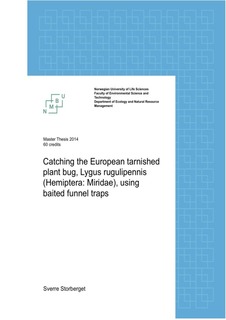| dc.contributor.author | Storberget, Sverre | |
| dc.date.accessioned | 2014-11-04T12:08:41Z | |
| dc.date.available | 2014-11-04T12:08:41Z | |
| dc.date.copyright | 2014 | |
| dc.date.issued | 2014-11-04 | |
| dc.identifier.uri | http://hdl.handle.net/11250/225347 | |
| dc.description.abstract | The European tarnished plant bug, Lygus rugulipennis, (Hemiptera: Miridae) is a highly polyphagous species considered a pest on numerous crops, among these strawberry causing malformed or “cat-faced” berries. No effective biocontrol agents are commercially available against this pest. To contribute in the development of traps for controlling L. rugulipennis in organic strawberry crops three studies investigating several aspects influencing catches were done in South-eastern Norway and in the UK. In the first study unbaited collision traps and funnel traps enhanced with green vanes and synthetic L. rugulipennis sex pheromone and/or a synthetic strawberry plant volatile (“PV2”) were set up and emptied fortnightly through most of the growth season in five strawberry fields (in Akershus, Norway). The plant volatile is a known attractant to another strawberry pest (the strawberry blossom weevil, Anthonomus rubi) and a possible attractant to L. rugulipennis as well. The sex pheromone was not found attractive to the new generation of L. rugulipennis in Norway. When PV2 was present less L. rugulipennis were caught. Compared to traps in semi natural/boundary habitat, the catches were significantly higher in strawberry crops. The PV2 attracted A. rubi as expected but not early in the season. In the second study one funnel trap baited with the L. rugulipennis sex pheromone blend was filmed for three days (in Kent, UK). All Lygus visiting the trap were recorded. Only between 7 and 18% were confirmed to be captured, all of them walking on the vanes for some time. The third study was to investigate the application of a slippery substance (Fluon) to the funnel would increase the trap efficiency of traps without cross vanes. The traps coated with fluon caught more than the control traps, but the difference was not significant on a 0.05 level. The traps did not seem to attract pollinators to any extent. To further develop the trap for higher catches the trap design has to be improved to increase the percentage of visiting L. rugulipennis to get caught. | nb_NO |
| dc.language.iso | eng | nb_NO |
| dc.publisher | Norwegian University of Life Sciences, Ås | |
| dc.subject | VDP::Landbruks- og Fiskerifag: 900::Landbruksfag: 910::Planteforedling, hagebruk, plantevern, plantepatologi: 911 | nb_NO |
| dc.subject | Lygus rugulipennis | nb_NO |
| dc.subject | Pest control equipment | nb_NO |
| dc.subject | Strawberries | nb_NO |
| dc.subject | Traps | nb_NO |
| dc.title | Catching the European tarnished plant bug, Lygus rugulipennis (Hemiptera: Miridae), using baited funnel traps | nb_NO |
| dc.type | Master thesis | nb_NO |
| dc.source.pagenumber | 42 | nb_NO |
| dc.description.localcode | M-ECOL | nb_NO |
